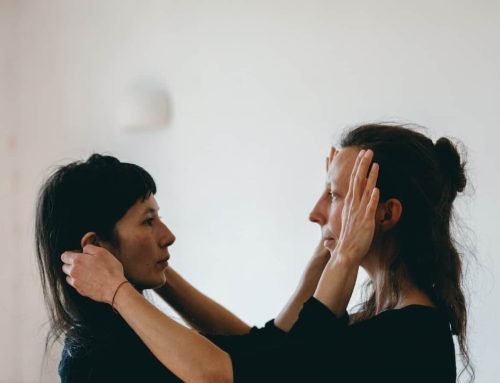Close to 50 years on from the show’s original trail-blazing Broadway outing much of A Chorus Line’s famed gritty verbatim realism feels both familiar and mainstream. The performers’ revelations of economic and emotional struggles, career uncertainties, racism, sexism, and homophobia, inspired by tape-recorded interviews with real-life Broadway gypsies, carry few surprises. The show’s dramatic structure, 17 performers whittled down in a real-time audition to a final successful cohort of 8, underpins practically every reality competition show on TV. The characters’ consciously inclusive camaraderie, intimate revelations, and performative soul-searching could come straight out of a slightly more adult version of The Great British Sewing Bee.
But Marvin Hamlisch’s tunes and Edward Kleban’s lyrics are timeless. Ellen Kane’s choreography is spectacular and absolutely flawless. The characters are as accessible and deeply sympathetic as they were five decades ago. Rather like Much Ado About Nothing, James Kirkwood and Nicholas Dante’s “anti-musical musical” masterwork, so named because it eschews the sugary worldview of the musicals of its time, is awfully, awfully difficult to muck up. Director Nikolai Foster’s 2021 revival, back at Sadlers Wells for a summer season prior to a UK tour, looks and sounds gorgeous and boasts outstanding performances all round. Just sit back and enjoy.
Lined up in on a single white line on a mostly bare audition stage, the 17 hopeful Broadway gypsies stand ready to strut their stuff through a combination of dance, monologue, and song. Holding court is demanding director Zach (post #MeToo the Sadlers Wells’ favourite Adam Cooper plays him an awful lot nicer than the movie’s Michael Douglas). Sidekick Larry (Ashley-Jordon Packer) wonders around with a sinister air and a video camera, the feed from which is projected much of the time against the theatre’s rear stage wall.
In some venues the video close-ups might feel intrusive and distracting, but in the cavernous space of Sadlers Wells they add a welcome sense of perspiring intimacy to proceedings. They also reveal just how hard this extraordinary ensemble cast works. One supposes the tech is a nod to the visual language of TV competition shows. Thankfully it is the only piece of obvious updating Foster engages in; the rest of the show feels resolutely 1975. Edd Lindley’s gorgeous costume palette – hippie Day Glo yellow, blue paisley, tight shorts, amber oranges, and dusky browns – looks like it a job-lot salvaged from the set of 70s TV show Charlie’s Angels. Grace Smart’s bare bones set, essentially a bare stage with rear mirrors and what seems to be a towering bank of speakers (that cleverly revolves mid-way to reveal the musicians) rightly focuses attention on the performers and their stories.
Redmand Rance’s cocky, self-assured Mike serves up a supremely athletic tap-dancing turn in I Can Do That. Archie Durrant’s Mark exudes saccharine innocence in Hello Twelve, Hello Thirteen, Hello Love, even if his pre-pubescent confusion between wet dreams and gonorrhea feels a little of its time. Chloe Saunders’ Val is all brash, foul-mouthed, charm in her homage to the power of plastic surgery Dance: Ten; Looks Three (also famously known by its chorus “Tits and Ass”). The uncomfortable power dynamic between erstwhile star Cassie (portrayed with brutal honesty by a gospel-voiced Carly Mercedes Dyer) and her former beau Zach, who she now needs to tap up for a lower status ensemble job, offers another a reminder of pre #MeToo working practices. Jocasta Almgill’s Diana, whose inability to connect with her inner self in acting class forms the topic of the beautifully rendered comic piece Nothing, blazes.
The dramatic high point of A Chorus Line, Paul’s (a diminutive, deeply likeable Manual Pacific) emotional revelations about his struggles with identity and his parents’ reactions to his sexuality, feel as raw and vulnerable as ever. The anthemic ensemble piece What I Did for Love, which follows Paul’s exit following an injury, nearly did not make it to the show’s final cut back in 1975. Here it is delivered with sublime understatement by the ensemble, a superb counterpart to the subsequent (breathtakingly delivered) showstopper One.
If there is a single stand-out star in Foster’s production, it has to be Howard Hudson’s lighting design. Of one of their previous gigs a character says, “everybody in the show danced, including the lights”. Foster brings this to life. Innumerable spots dart from all corners of the theatre and drop down in bank after bank from the roof to the stage. Waves of lights above undulate in time with the music. It is quite simply awe-inspiring. This is an impeccable production of a masterpiece.
Book: James Kirkwood & Nicholas Dante
Music: Marvin Hamlisch
Lyrics: Edward Kleban
Director: Nikolai Foster
More Recent Reviews
The King of Hollywood. White Bear Theatre.
Douglas Fairbanks was a groundbreaking figure in early American cinema. Celebrated for his larger-than-life screen presence and athletic prowess, [...]
Gay Pride and No Prejudice. Union Theatre
Queer-inspired reimaginations of Jane Austen’s Pride and Prejudice are a more common species than one might initially imagine. Hollywood [...]
Knife on the Table. Cockpit Theatre.
Knife on the Table, Jonathan Brown’s sober ensemble piece about power struggles, knife violence, and relationships in and around [...]




